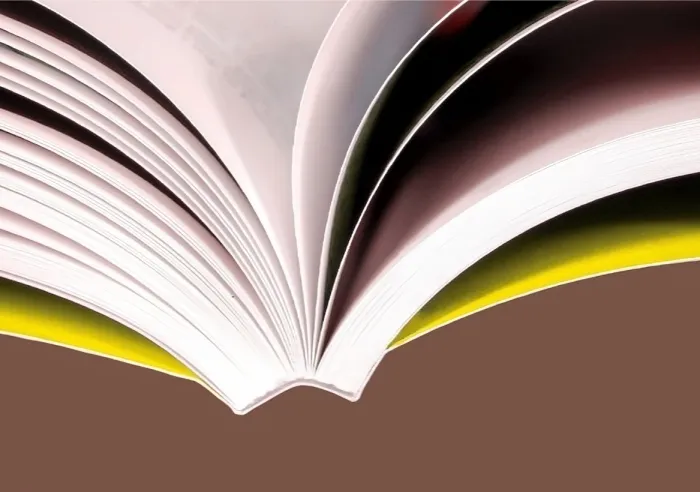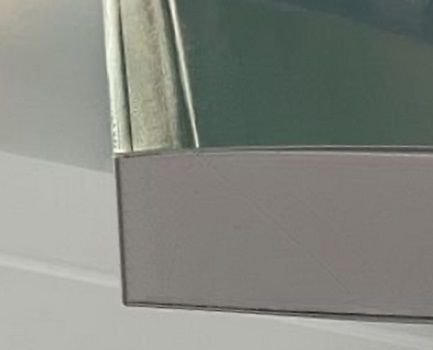PUR Bound Books: 7 Types of Books that call for PUR Binding

estimated reading time: 8 minutes
PUR Binding is a variant of the popular Perfect Binding method
Step into any bookstore in North America, and you'll find
that most of the titles lining the shelves are Perfect Bound books. Perfect
Binding is an immensely popular bookbinding method thanks to its affordability
and professional appearance. Perfect Binding produces books that have a flat
spine, crisp corners, and straight, uniform edges - qualities that give "Perfect
Binding" its name.
The Perfect Binding method uses a hot-melt glue to adhere a
block of pages within a wrap-around cardstock cover. There are two primary
types of hot-melt glue used in the production of perfect bound books - Ethylene
Vinyl Acetate (EVA) and Polyurethane Reactive (PUR).

EVA Glue vs PUR Glue
Used for bookbinding since the 1960's, EVA glue is a general
purpose hot-melt adhesive that bonds securely to most uncoated paper stocks.
However, it can sometimes have issues bonding to coated stocks and recycled or
synthetic paper. EVA is also prone to failure when exposed to extreme
temperatures - becoming brittle in cold temperatures and softening in high
temperatures.
PUR glue started to gain popularity for bookbinding in the
1990's. It has proven to outperform EVA in many ways. Compared to EVA glue, PUR
offers greater bonding strength, superior flexibility, and improved performance
in extreme temperatures.
PUR glue also has a wider range of paper compatibility.
Unlike EVA glue, PUR forms a chemical bond as it cures. This creates
exceptional gripping power, enabling PUR to strongly adhere to coated stocks,
thicker cardstocks, recycled paper, and even slicker surfaces like laminates,
Mylar, and synthetic papers.
7 Types of Books that are an Ideal Fit for PUR Binding
1. Books made with Glossy Paper Stocks
Books that aim to make a strong visual impact, such as those
that contain vibrant colors and highly-detailed images, are often made with pages
that have a glossy finish. The glossy surface coating adds sheen and slickness
to the paper. This helps retain image sharpness and accurate color reproduction, giving
photos, illustrations, and text a crisp, high-contrast look.

Books that are commonly made with glossy pages include
children's picture books, cookbooks with colorful recipe photos, full-color
graphic novels, and books that display art, photography, or illustrations.
Magazines and Catalogs are other common examples of bound
documents that usually have a gloss finish. The glossy sheen makes photos of people
and products look more appealing.
EVA glue is prone to adherence issues when used with glossy paper
stocks, but PUR glue bonds securely to glossy paper.
2. Books that will be subject to Frequent Use
Mystery novels, self-help books, installation guides, and event
programs are all examples of books that generally get read only once. However,
there are other types of books that are referred to often, being subjected to
frequent handling, opening, and page-turning. In order to withstand repeated use without the
pages loosening or the spine breaking, these books need to be made with a
durable binding method.
For example, there are many types of manuals that get
referenced on a regular basis. These include operation manuals, maintenance and
service manuals, policy and procedure manuals, safety manuals, price manuals,
and so on.
Other examples of frequently used books include employee
handbooks, directories, reference books, repair guides, and workbooks. Also,
religious books - such as prayer books, devotionals, and meditation guides - are
often referred to multiple times per week (or daily).
Unlike EVA glue, the high bonding strength of PUR glue keeps
the pages of frequently used books intact.
3. Books that may incur Rough Handling
By nature, some types of books are subject to rough handling.
Whether getting passed between multiple
users, tossed into backpacks, or used in environments where they might get bent,
dropped, or handled carelessly, these books need sturdy binding to withstand
the rough treatment.

For example, certain books - such as equipment
troubleshooting or service manuals - are used in factories, construction sites,
and other industrial settings where rough handling can occur. The same can be said for field guides and manuals
used in rugged outdoor conditions and exposed to constant handling and/or rough
terrain.
Children's Books are another book type that isn't always
treated gently. Toddlers have been known to fling books around and yank on the
pages.
Any book that has the potential for being handled roughly
will benefit greatly from the strength and flexibility of PUR binding.
4. Books that will encounter Temperature Extremes
Extreme heat, cold, or rapid temperature fluctuations can
have a negative effect on softcover books bound with EVA glue. EVA glue can become
brittle and crack in cold temperatures. It can also soften in hot temperatures,
causing the pages to loosen and separate from the book's cover.
Obviously, this can cause a problem for any books that might
be subject to temperature extremes, such as reference guides or manuals stored
in work vehicles, or in garages, workshops, warehouses, and other structures that
aren't climate controlled.
Some books are specifically intended for outdoor use, such
as field guides, first aid books, and survival manuals. Of course, these types
of books should also avoid using EVA binding glue.
Fortunately, a book bound with PUR glue retains its
structural integrity even when subject to temperature extremes. PUR books
remain functional and intact whether the temperature is 300 degrees Fahrenheit
or well below zero.

5. Books with pages made of Recycled Paper
Some companies, authors, and self-publishers prefer to use
recycled paper for their books. This is usually done to demonstrate their
eco-friendly values, or perhaps they just like the look and texture of recycled
paper.
However, EVA glue does not always bond well to recycled stocks.
The reason is because the wood fibers in recycled paper are physically shorter than the fibers in virgin paper. This is largely
due to the process of re-pulping. Shorter fibers give the glue less surface
area on which to form a strong bond. A more thorough explanation is below…
During the paper manufacturing process, paper mills extract wood
fibers from trees using various mechanical and chemical processes (coniferous
trees have longer fibers so these are the types of trees used most frequently
for paper production).
The wood fibers are used to create a watery pulp mixture,
which is spread over a large moving conveyor of wire mesh. The pulp is then pressed
with heavy rollers to remove excess water and compact the wood fibers into a
sheet. The sheet then undergoes drying and finishing steps before it is wound
into a huge roll. From there, it can be cut into smaller rolls or individual sheets.
Virgin paper goes through the above process one time.
However, as you would expect, recycled paper goes through the pulping process at
least one additional time. Because each pulping process further breaks down the
paper fibers, the fibers become physically shorter each time the paper is recycled.
As mentioned, the shorter fibers in recycled paper means
there is less surface area for the binding glue to grab onto. This is an issue
for EVA glue because it relies primarily on "mechanical" bonding - where the
melted adhesive merely intermingles with the paper fibers as it cools.
However, PUR glue can securely bind recycled paper stocks. This
is because PUR cures through a chemical reaction between the glue and the
substrate being bound. The molecular cross-linking that occurs is what gives
PUR its superior strength and adhesion properties.
6. Books that will be Transported Frequently
Some books are intended to be carried around. These portable
books require a durable binding adhesive because they generally see high use, plus
they are usually shoved repeatedly into a pocket, handbag, or backpack for
easier transport. In addition to strength, the binding will also need to have
flexibility in order to withstand being handled so often.
For example, pocket-sized reference books, such as those
used to look up industry standards, formulas, codes, etc., are purposely
designed to be carried around in a shirt, jacket, or pants pocket for quick
reference.
Field guides, that help identify animals, plants, and other
things found in the natural world, are another example of books created for
on-the-go use, as are travel and sightseeing guides. Also, textbooks and
workbooks are repeatedly carried by students from school to home and back
again…for months at a time.
PUR binding offers the strength and flexibility needed for portable,
travel-friendly books.

7. Books with pages made of Synthetic Paper
Synthetic paper is made from polypropylene or polyethylene resin
instead of wood pulp. It functions like traditional paper but is much more
durable. It offers excellent resistance to tears, moisture, and grime. It is
used for books that need to withstand heavy use and/or damp or dirty
conditions.
As such, synthetic paper is a reliable choice for books intended
for outdoor use, such as field guides or survival manuals. It is also a good
choice for books used where water or other liquids might be present, such as in
a commercial kitchen, aboard a marine vessel, or near swimming pools, lakes, or
other bodies of water.
Synthetic paper is also suitable for first aid and emergency
guides since it can hold up to whatever environmental conditions may be
present. Plus, because it is virtually tear proof and allows dirt and spills to
be easily wiped off, it is a good fit for children's books.
Since synthetic paper has a very smooth, plastic-like surface,
EVA glue can have trouble adhering to it effectively. However, PUR glue has no
trouble bonding firmly to smooth or slick surfaces, thus making PUR the recommended
choice for books created from synthetic paper.
Color Vision offers PUR bound books at very affordable prices!
Color Vision has been producing books for over four
decades. We offer a wide range of printing, binding, and finishing options to help
your book stand out from the crowd.
Even though PUR is a superior binding adhesive, Color Vision
does not charge extra for it. This means you get all the benefits of PUR
binding without paying a penny more.
So if you have an upcoming book project, fill out our
simple Quote Request form and we will be happy to email a quote to
you. Or, if you prefer to discuss your project by phone, we can be reached
at 800-543-6299.
As always, we look forward to assisting with your custom
printing needs!
Related Articles

Creating a Comic Book? Here’s some Advice from a Printer
Read This Article

Perfect Binding vs PUR Binding: What is the Difference?
Read This Article

Perfect Bound Book Printing: Tips for getting the Best Value
Read This Article

How Much Does It Cost to Have Books Printed?
Read This Article